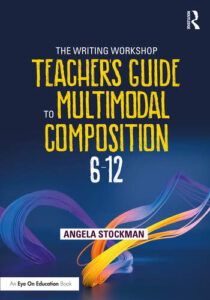Useful Teacher’s Guide to Multimodal Composition
The Writing Workshop Teacher’s Guide to Multimodal Composition, 6-12
By Angela Stockman
(Routledge/Eye On Education, 2022 – Learn more)
Reviewed by Megan Balduf

I already bring in a variety of multimodal texts while teaching reading skills, and I hoped Stockman’s work would help bridge the gap in my writing instruction. Unfortunately, in my excitement, I did not notice the phrase “The Writing Workshop” in smaller print above the main title.

Understanding multimodal composition
One of the most beneficial pieces of the text was Stockman’s argument in favor of multimodal composition. Her definition eliminates some of the mystery around how teachers can help students create such pieces. She notes that society places inherent value on written communication, devaluing or undervaluing non-linguistic modes.
I found the descriptions of various modes and the list of critical design pieces for each mode particularly helpful as both support teachers and students moving away from traditional print-based responses.
How writer’s workshop can impact multimodal composition
Stockman takes readers through how to structure the writer’s workshop to accommodate multimodal composition. A few chapters (2 and 3) were specifically about setting up a writer’s workshop structure that would foster multimodal composition. As I don’t run a writer’s workshop, I found concepts I would like to use but which will require substantial revision.
However, I found the introduction of Julie Stern, Trevor Aleo, Kayla Duncan, and Krista Ferraro’s ACT: Learning Transfer model in chapter 4 especially revelatory. The ACT model – acquire skills, connect them to other skills, and transfer the skills to new contexts – is what I attempt to do in my work with students, so the framework provides another structure on which to build my curriculum.
I was hoping Stockman’s chapter on assessing multimodal composition would be practical, but it was more theoretical. She mentioned great ideas about documentation, feedback, and conferencing, but one of my struggles with multimodal composition is fair and adequate assessment, which Stockman did not directly address.
The elements of multimodal composition
For those teachers ready to start, or already on the journey to incorporating, multimodal composition in their workshops or classrooms, the third section of Stockman’s text is invaluable. Stockman provides a list of essential elements of multimodal composition, and I found the questions she posed with each element beneficial in planning mini-lessons as students work.
Stockman also walks readers through how to provide different forms of feedback. I had heard of but didn’t fully grasp the difference between warm and cool feedback, but Stockman’s explanations helped place those in the context of my current instructional practices.
Each chapter ends with what Stockman calls her “Sixty Second Reflection.” Her questions encourage readers to engage more fully with the ideas presented. If I truly want to embrace Stockman’s ideas, change is necessary (but not easy). Reading through, and reflecting on, the questions in each chapter was often uncomfortable, yet there was great benefit to examining my practices.
Powerful writing instruction in the Appendices
The Appendices, in and of themselves, are worth getting this teacher’s guide. From ways to provide timely, actionable feedback to mentor texts for various modes, there is a treasure trove of information at the close of the book. I made more annotations here than almost anywhere else.
At times, not running a writer’s workshop like Stockman describes created the need to transpose Stockman’s ideas into what would work in my classroom. However, the appendices focus on powerful writing instruction generally, so the ideas presented felt more immediately applicable.
If you want to expand the kinds of writing your students do – regardless of whether you support a writer’s workshop – Stockman’s book has great information to help.
Megan Balduf (@MBalduf) is a middle school English teacher with nineteen years’ experience. Being a classroom teacher was always her dream, and her experience allowed Megan to become a teacher leader, including being part of AMLE’s Teacher Leader Constituent Committee. Since entering the classroom, Megan has earned an MA in Gifted Education and an MA in English for Language Arts Teachers, and has become a National Board Certified Teacher.


































